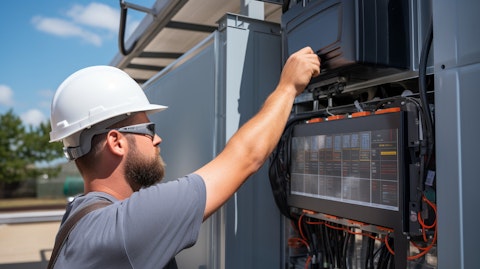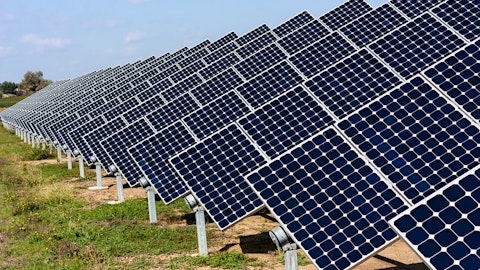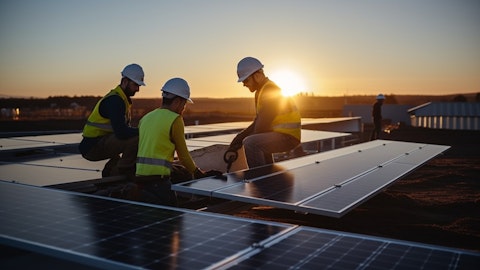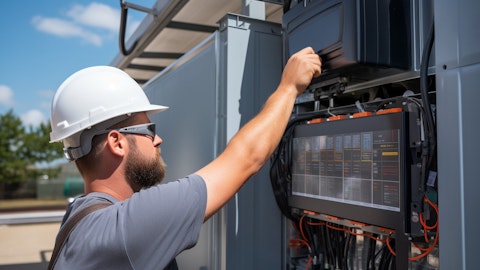SunPower Corporation (NASDAQ:SPWR) Q4 2023 Earnings Call Transcript February 15, 2024
SunPower Corporation misses on earnings expectations. Reported EPS is $-0.51 EPS, expectations were $-0.27. SPWR isn’t one of the 30 most popular stocks among hedge funds at the end of the third quarter (see the details here).
Operator: Good morning, welcome to SunPower Corporation’s Fourth Quarter and Full Year 2023 Earnings Call. At this time, all participants are in a listen-only mode. After the speaker’s presentation, there will be a question-and-answer session. [Operator Instructions] Please be advised, today’s conference is being recorded. I would now like to turn the call over to Mr. Mike Weinstein, Vice president of Investor Relations at SunPower Corporation. You may begin.
Mike Weinstein: Good morning. I would like to welcome everyone to our fourth quarter 2023 earnings conference call. On the call today, we will begin with comments from Peter Faricy, CEO of SunPower, who will provide an update on Q4 business highlights, recent cost reduction actions and our recent announcement of fresh capital from our majority shareholders along with our entrance into new long-term waivers from key financial partners, and our entry into an amendment to our revolving debt facility. Peter will also provide a view of key drivers for improved profitability and cash flow in 2024, along with updates on New Homes and SunPower Financial. Following Peter’s comments, Beth Eby, SunPower CFO, will then review our financial results.
Peter will close with guidance for gross margin and cash flow improvement in 2024 and beyond. As a reminder, a replay of the call will be available later today on the Investor Relations page of our website. During today’s call, we will make forward-looking statements that are subject to various risks and uncertainties, and our actual performance and results may differ materially from our forward-looking statements. These risks and uncertainties are described in the forward-looking statement disclaimers contained in today’s slide presentation, today’s press release, our 2022 Form 10-K/A, and our quarterly reports on Form 10-Q. Please see these documents for additional information regarding factors that may affect forward-looking statements and read the forward-looking statement disclaimers contained therein.
Also, we will reference certain non-GAP metrics during today’s call. Please refer to the appendix of the presentation as well as today’s earnings press release for the GAAP to non-GAAP reconciliation. Finally, to enhance the call, we have posted PowerPoint slides, which we’ll reference during the call on the Events & Presentations page of our Investor Relations website. We have also posted a supplemental data sheet detailing additional historical metrics. With that, I would like to turn the call over to Peter Faricy, CEO of SunPower. Peter?
Peter Faricy: Thanks, Mike, and good morning, everyone. Today I will discuss our Q4 2023 results, our recent injection of new capital, and the expected impact from cost reduction actions taken in the last few months. We believe these cost reductions will make meaningful improvements to profitability and cash flow later this year and beyond. 2023 was one of the toughest years this industry has had to endure and we know that last year was as frustrating for you as it has been for us. We have been taking concrete actions designed to position the company for success in 2024 and beyond even if consumer demand declines. I look forward to sharing with you how we intend to continue delivering the best customer experience in the industry, while we aim to reduce costs and improve profitability going forward.
Please turn to Slide number 4. I’m pleased to report that we have successfully raised $200 million of new capital commitments, including $175 million of second lien debt from Sol Holding, the JV between TotalEnergies and GIP that holds a majority of our shares outstanding, which is inclusive of the $45 million of bridge loan financing already provided since December. In addition, we have also obtained new long-term waivers from key financial partners and entered into an amendment to our revolving debt facility that includes access to an incremental $25 million of revolver capacity. Please turn to Slide number 5. In the fourth quarter, difficult market conditions continued, driven by higher interest rates and net metering policy changes in California under NEM 3.0. As I will discuss further in a few moments, we’ve already taken actions that we estimate will result in approximately $100 million of analyzed run rate savings, most of which we expect to be realized by midyear 2024.
We added 16,000 new customers for the quarter as we transitioned away from NEM 2.0 installations. Our backlog of 52,100 homes this year reflects a combination of retrofit and new homes channels, including a growing multifamily segment. Retrofit backlog now stands at 15,100, reflecting both our ability to execute on installations as well as a deliberate effort to resolve pending cancellations at year end. New Homes backlog remained mostly steady at 37,000, while New Homes installations continued to improve and grew 19% in Q4 versus Q3. I’ll have more to add on our New Homes segment in a few minutes. We began to see some improvement in new sales bookings in September, and overall net bookings for Q4 were down 24% year-over-year on a revenue basis, including the resolution of cancellations.
Winter is a seasonally slow period for the industry, as many of you know, so we will be looking for further signs of improvement in the spring. We continue to anticipate a growing value proposition for our customers over the long term as we expect traditional retail electric costs to rise, while solar and storage equipment costs decline in the years to come. And that further clarity on solar tax credits for domestic content will also come to light over time. Storage and SunPower Financial sales attach rates continue to be bright spots for the quarter, with the Storage attach rate at 76% in our California Direct Channel and a 23% attach rate overall. Moreover, storage attach rates for full year 2024 are expected to continue improving as we transition away from SunVault to expand our offerings and include a grid-tied option for consumers.
SunPower Financial reached a record setting 65% attach rate for the quarter and continues to benefit from strong consumer interest in lease contracts. As noted previously, further growth for leasing is expected in 2024 and beyond due to a combination of lease payment competitiveness versus higher utility bills and bonus tax incentives under the Inflation Reduction Act. SunPower remains customer-centric and agnostic toward lease or loan financing, and we believe that our continued access to capital markets as a top-tier residential solar company is a competitive advantage. As we begin this year, we’ve decided to simplify the financial metrics we provide to you, and we’ll no longer provide a calculation of EBITDA per customer before platform investment.
With our emphasis on profitability under current market conditions, we are shifting our attention towards gross margin and cash flow going forward, and I’ll share the details on that shortly. Please turn to Slide number 6. We see several factors at work this year that we believe provide a highly visible path towards improved profitability and cash flow. First, we’ve already executed on nearly $100 million of COGS and OpEx savings, which we believe will recur annually with about two-thirds of these savings from reduced COGS, including the previously announced consolidation of SunPower Direct installation sites, lower cost panels, lower freight costs, and reduced overhead. Furthermore, the majority of OpEx reduction actions are related to labor costs with the remainder from facilities costs.
The cost to achieve these savings is relatively $9 million expected to be incurred in 2024. Second, we expect to benefit in 2024 from new relationships with key suppliers, as well as lower cost of equipment, particularly panels. As our supply chains evolve and diversify, we expect to see opportunities to provide more value to consumers and shareholders without sacrificing quality as supplier competition heats up over the next few years. We expect to realize as much as a 37% decline in overall equipment expense from lower cost panels, inverters, and racking systems. Please turn to Slide number 7. We are pleased to be able to achieve material cost savings without having to sacrifice quality. Using panels as an example, you can see that premium manufacturers are converging on panel efficiency.
At the same time, best-in-class premium panel makers have also been able to achieve new levels of lower cost. We believe we can continue to offer customers and dealers the highest quality products now at prices that are much more affordable. Please turn to Slide number 8. New homes performed better than expected in 2023 as the homebuilding industry proved to be surprisingly resilient in the face of higher mortgage rates. Under our conservative assumption for slow growth and retrofit sales this year, we expect new homes to take a larger share of our overall sales mix in 2024. Total Q4 new homes bookings increased 18% versus Q3, and we’ve seen that momentum continue in early 2024. We saw even better momentum in California with an increase of bookings of 32% versus Q3.

New home storage sales under NEM 3.0 in California increased 30% in Q4 versus Q3, holding steady at 22% attach rate. From an install perspective, we saw Q4 installations increase sequentially 19% versus Q3, declining only 4% year-over-year. Our latest backlog estimate of 37,000 homes reflects approximately 18 to 24 months of installations depending on the pace of home sales themselves. In 2024, we expect installations to grow compared to 2023 in tandem with more new home construction. Please turn to Slide number 9. SunPower Financial continues to grow its footprint across our sales operation, achieving a record high 65% customer attach rate in Q4, already entering the 2025 target range we previously set at our Analyst Day. This growth has been driven by strong consumer uptake of lease contracts, which comprise 73% of the lease and loan financing in Q4 versus 26% the year prior.
We now have raised nearly $1.8 billion of loan and lease funds over the past 24 months. We plan to continue growing this program with additional partner funds over the coming months. We’re also exploring opportunities to establish a regular programmatic approach to project financing, particularly tax equity, and we continue to keep an eye on the securitized product markets for additional value opportunities. Please turn to Slide number 10. We believe that SunPower Financial continues to bring multiple competitive advantages to the table, including: one, a lower cost of customer acquisition; two, a customer-focused sales approach whereby SunPower earns similar origination fees for lease or loan products; three, a lower cost of capital driven by lower default rates from customers using higher quality equipment under an industry-leading remote monitoring system employing sophisticated digital analytics to identify problems early; and finally, a longer history of granular customer payment data that goes back to 2009.
Please turn to Slide number 11. With U.S. residential solar market penetration of only 4% to 5%, we view conventional electric utility rates as the primary competition for our industry. The U.S. Energy Information Agency reports that average U.S. retail electric rates remain near all-time highs as of November, despite lower costs of bulk wholesale power and key fuels, such as natural gas. Price increases continue to hit the northeastern and mid-Atlantic states and California, with nearly 28 million potential customers in 10 states seeing increases greater than 10% year-over-year. We estimate that more than 50 million potential customers reside in states where electric rates rising faster than the cost of inflation. In California, PG&E rates rose 13% in January, with further increases under review.
We believe that these steep cost increases and the impact of grid and stability on residential customers continue to elevate the value proposition of residential solar as one of the most powerful ways to stabilize and reduce home electric bills. Despite lower fuel prices, the Edison Electric Institute is projecting a 20% increase in electric utility capital investment from 2023 to 2025 compared to the previous three years. As these investments are recovered through electric bills, we continue to believe that the value of rooftop solar is likely to continue rising. Please turn to Slide number 12. As we look forward to 2024 with a leaner operation and a recapitalized balance sheet, I want to highlight what we believe is the most important differentiating factor that continues to distinguish SunPower from the rest of the pack.
A customer experience that is second to none. Despite the financial struggles we’ve seen these past few months, SunPower remains top rated with customers earning an A+ rating with the Better Business Bureau and four to five star reviews with thousands of customers across multiple review sites. Our reputation is hard earned through the hard work and thoughtful interactions of thousands of SunPower employees and our incredible dealers. It continues to be enhanced with an improving digital experience that encompasses the entire customer life cycle, from system design to energy management, to ongoing and efficient customer support. I’ll now turn you over to Beth for more details on our Q4 results and then I’ll close with some guidance for 2024.
Beth?
Beth Eby: Thank you, Peter. Please turn to Slide 14. For the fourth quarter, we’re reporting negative $68 million of adjusted EBITDA and $361 million of non-GAAP revenue. Lower year-over-year installations at 16,000 reflect the impact of reduced booking since May under higher interest rates and a California NEM 3.0 environment, as well as the winding down of NEM 2.0 installations. Increasing battery attach rates since 2022 have been driven by NEM 3.0 demand in California, as well as lower cost options. We expect to sell out of SunVault and shift to lower third party cost — lower cost third party batteries in Q2. Adjusted gross margin declined in Q4 as a result of SunPower Direct pre-install and install costs spread over lower volumes.
Costs are expected to improve in 2024 after recent restructuring actions. Several items totaling $48 million are also either not expected to recur in 2024 or were time shifted into Q1. Including the restatement impact, adjustment for inventory write down, warranty costs mostly related to our commercial business that we sold in 2022, a higher lease cost of capital on systems installed due to rapid interest rate increases which were unhedged and the delay of recognition reduced ITC warranty reserves on legacy projects from Q4 to Q1. Please see the appendix for more detail. Turning to the balance sheet, we ended Q4 with $87 million cash on hand and $208 million of net recourse debt. Inventory levels declined another $64 million to $261 million on December 31st with efforts to reduce further continuing into 2024.
We continue to value our ownership of lease renewal, net retained value in SunStrong using a 6% discount rate. With growth in the portfolio, we now estimate the value of our stake to be about $320 million. Before we turn the call over for Q&A, I want to turn you back over to Peter for guidance on 2024 and closing comments. Peter?
Peter Faricy: Thank you, Beth. Please turn to Slide 15. So, I mentioned earlier we are shifting our reporting and guidance approach a bit to emphasize gross margin and cash flow rather than platform investment. That said, we’ve decided against providing customer and EBITDA guidance on 2024 demand at this early stage, particularly as we intend to drive results this year through a combination of restructuring, carefully considered cost reductions, and prudent working capital stewardship. Given the challenging market conditions, we are providing guidance on: number one, cash flow; and number two, gross margin. With respect to cash flow, we are guiding to be cash flow positive for the second half of the year as lower inventory, lower inventory costs, and reduced OpEx all kick in.
We are also guiding to continue this trend to be cash flow positive for 2025 as well. We are projecting a range of full year gross margins of 17% to 19%, improving to greater than 20% in 2025. We planned to update you with full year EBITDA guidance later in the year once we’ve had the opportunity to complete an evaluation of our ongoing restructuring and recently announced recapitalization impacts. We’ve deliberately been conservative in our strategic planning for the year, and we’re fully focused on goals for profitability, cash flow, and results as we work to improve our financial strength this year to remain an industry-leading residential solar company for 2025 and beyond. Please turn to Slide 16. This slide is largely the same one we showed you last quarter and continues to list our view of the future as we reset and launch forward into 2024 after a difficult 2023.
From a macro perspective, we continue to expect that increasing utility rates and lower equipment pricing will be tailwinds for the industry. We also anticipate a more stable interest rate environment as well as improved clarity on how the bonus tax credits available under the Inflation Reduction Act. For SunPower specifically, we expect to benefit from lower cost products as mentioned earlier. Finally, while we have reduced OpEx and de-emphasized plans for high growth platform investment this year, we plan to keep an eye on long-term opportunities for growth and investment, adjusting our level of cash usage up or down based on our expectations regarding the strength of the market in future periods. With that, operator, I’d like to turn the call over for questions.
Thank you.
See also 25 Countries That Gave the Most Foreign Aid in 2023 and 16 Easiest Countries to Immigrate to Without a Degree.
Q&A Session
Follow Sunpower Corp (NASDAQ:SPWR)
Follow Sunpower Corp (NASDAQ:SPWR)
Operator: Thank you. [Operator Instructions] And our first question is going to come from the line of James West with Evercore ISI. Your line is open. Please go ahead.
James West: Thanks, and good morning, Peter and Beth.
Peter Faricy: Good morning, James.
James West: Peter, I’m curious, wonder maybe if you could provide some context around the recent capital commitments that were made, particularly with [indiscernible] and GIP and kind of how that all came together. Just kind of thinking through their level of support because it’s obviously pretty clear that there’s a lot of support for SunPower and I just wanted to get a little more color.
Peter Faricy: Yes. Thanks, James. So I think the number one question on the minds of shareholders and investors has been our liquidity, appropriately so. And so, most of the reports, I think, that I’ve read or that came out last year thought that SunPower needed something on the order of $100 million to get liquidity back in order. So I guess the first thing I’d put in perspective is the $200 million capital commitment is we’re pleased, I guess is the way to say it. We’re pleased at that level of capital commitment because I think that puts us in a position to have the liquidity we need to execute against our business plan this year. And a big part of the business plan, as I mentioned in my opening remarks, is getting us to cash flow positive and getting us back on this positive trail.
And then I think as you point out, the second part of this that is a very big deal is that, you’re looking for signals from your majority shareholders. Total Energies and Global Infrastructure Partners are two of the most successful companies and investors in the energy space globally. And when they put their capital behind something, it’s after a lot of due diligence and a lot of homework and a strong belief in the future of the company. So I really believe the second message here, besides the fact that $200 million is a very big number, is just the fact that they’re so committed to the future of the company.
James West: Right. Totally agree it on my side. And then what are your thoughts on the need for additional lease capital as we go through this year?
Peter Faricy: Yes, that’s a great question. So to take a step back, we had a terrific year in SunPower Financial as we pointed out in the slides and opening remarks, really the idea that we could grow our attach rate from 39% to 65% last year was great. That’s a really great signal that more and more dealers and more and more customers are preferring to get their lease and loan financing from us versus other third parties. So that trend is terrific, and we expect that to continue this year. And really, if you take a look at the capacity we have undrawn, on the loan side, we’re really in great shape. We have a $900 million of available capacity. We’re in a year where most people believe interest rates will stabilize, possibly have a chance to decline over the year.
And if loans begin to be more favorable, we’re in a really good position. But really, really where we want to build a lot more capacity is on the lease side. And as we pointed out, I think it’s true across the industry as well, but we just had enormous growth last year because the value of lease has increased over the value of loans. So we don’t have anything to announce on this call, but I would say stay tuned because increasing our lease capacity is our top priority after today’s call.
James West: Got it. Thanks, Peter.
Peter Faricy: Thanks, James.
Operator: Thank you. And one moment as we move on to our next question. And our next question is going to come from the line of Colin Rusch with Oppenheimer & Co. Your line is open. Please go ahead.
Colin Rusch: Thanks so much, guys. Can you talk a little bit about the pricing dynamics? As you’ve gotten through a couple of quarters in California with NEM 3.0 and you start shifting the mix of what folks are buying. Can you just talk about on an apples-to-apples basis how you’re seeing pricing evolve in that market over the last, call it, three quarters?
Peter Faricy: Yes. So, I guess, two things on California. One is, to be frank, we are disappointed that the market hasn’t recovered faster than it has. We did see some, I’d say, very modest recovery as we got to the end of the year, but clearly NEM 3.0 has had a big impact on consumer demand. Having said that, the consumers that are buying under NEM 3.0, there’s two characteristics I’d point out so far. One is that, as we talked about in my opening remarks, the battery attach rates are very high, and that’s just for rational reasons. For all the customers in California, your savings is maximized by the addition of a battery. And so, I would expect at some point, all customers in California who order solar panels, batteries will be seen as almost a standard product along with solar panels.
And then two, what we’re seeing is that system sizes have increased a little bit over NEM 2.0. It’s a modest increase, but it is a material increase enough that that’s driving up a little bit higher overall [ring] (ph) per customer in California. But I think that the big deal for California is really I think it’s to me it’s questionable whether California is going to be able to meet its clean energy goals without reassessing whether or not an NEM 3.0 had the impact they thought it would. And I think from our perspective, we’re concerned that California is not in a position to meet its goals with the current program that’s out there. So we’re working with our dealers and customers to make the best of the current program, but I would say the feedback from consumers in California and dealers is very consistent.
I think NEM 3.0 has clearly slowed down demand. And in the long run, that’s not great for anybody in California.
Colin Rusch: That’s super helpful. Thanks. And then in terms of your dealer strategy and how you’re working with those folks, given the evolving landscape both from a regulatory perspective as well as from a capital perspective and looking at where you run into some issues with that dealer channel. Can you talk about where you’re seeing incremental need to edit those things, edit those relationships, or evolve that strategy at all?





